Drawing Blood, Drawing Poison, Drawing Fire – a pre-launch Q&A with the artist, Simon Grennan.
Funded by the Arts Council and led by artist Simon Grennan, ‘Drawing Blood’ is a new collaborative art project that creates a new online exhibition of twenty new, original animated artworks. Hosted by Gladstone’s Library, the online exhibition will also be available at Contemporary Art Space Chester and at Aura libraries in North Wales, including Broughton, Buckley, Mold, Deeside, Holywell, Connah’s Quay and Flint.
The new artworks are inspired by a book Simon found in the Gladstone’s Library collections. Dating from 1878, Gladstone from Judy’s Point of View collects cartoons satirising one of the hot topics of the period – liberal political opinion. As one of the major Liberal politicians, William Ewart Gladstone is often in the firing line of Judy’s cartoonists. In the tradition of political artists everywhere their pens puncture any political pomposity, drawing Gladstone (and others) not as respected statesman but as wobbly juggler, unstable acrobat, indecisive whirligig, pram-pushing lady, and many more.
Ahead of the exhibition’s launch, Simon gave us some exclusive insights into the production process. They’ll be posted on this blog each week: for a full list, please visit the project’s home page: https://www.gladstoneslibrary.org/reading-rooms/digital-gladstone/drawing-blood-drawing-poison-drawing-fire
Who drew the Victorian cartoons?
A few of the cartoons in the collection William Gladstone from ‘Judy’’s point of view, from the last ten years were drawn by John Proctor (1836 – 1914). Proctor was a successful painter, illustrator and cartoonist. He was a cartoonist for the London magazine Judy between 1867-68, for the Illustrated London News in 1874 and for Sketch in 1893. He illustrated many books including the 1887 edition of Jane Austen’s Pride and Prejudice. However, most of the cartoons in the collection were drawn by William Boucher (1837 – 1906). Boucher drew the large two-page centre spread cartoon each week in Judy for over 20 years, making him one of the greatest rivals to John Tenniel (1820 – 1914), the illustrator of Alice in Wonderland. Like Tenniel, he contributed illustrations to numerous important works of fiction, including Robert Louis Stevenson’s The Black Arrow and Kidnapped for the Young Folks Paper. Both Proctor and Boucher drew according to the editorial position of Judy, which was socially and politically conservative (opposing Irish self-rule, for example), despite the magazine pioneering the appearance of articles and features specifically for women readers.
Pwy dynnodd luniau’r cart?ns Fictoraidd?
Rhai o’r cart?ns yn y casgliad William Gladstone from ‘Judy’s Point of view, from the last ten years, wedi eu tynnu gan John Proctor (1836 – 1914). Roedd Proctor yn baentiwr llwyddiannus, darlunydd a chartwnydd. Roedd yn gartwnydd i gylchgrawn Llundain Judy rhwng 1867-68, ar gyfer yr Illustrated London News yn 1874 ac ar gyfer Sketch yn 1893. Roedd yn darlunio llawer o lyfrau gan gynnwys rhifyn 1887 o Pride and Prejudice. Fodd bynnag, roedd y rhan fwyaf o’r cart?ns yn y casgliad wedi eu tynnu gan William Boucher (1837 – 1906). Roedd Boucher wedi tynnu’r cart?n canol dwy dudalen fawr bob wythnos yn Judy ers dros 20 mlynedd, yn ei wneud yn un o gystadleuwyr mwyaf John Tenniel (1820 – 1914), darlunydd Alice in Wonderland. Fel Tenniel, roedd wedi cyfrannu darluniau i nifer o waith ffuglen pwysig, gan gynnwys gwaith gan Robert Louis Stevenson The Black Arrow a Kidnapped for the Young Folks Paper. Roedd Proctor a Boucher yn darlunio yn ôl lleoliad golygyddol Judy, oedd yn geidwadol gymdeithasol a gwleidyddol (yn gwrthwynebu hunan-reolaeth Gwyddelig, er enghraifft), er gwaethaf y cylchgrawn yn arloesi ymddangosiad erthyglau a nodweddion yn benodol i ddarllenwyr benywaidd.
